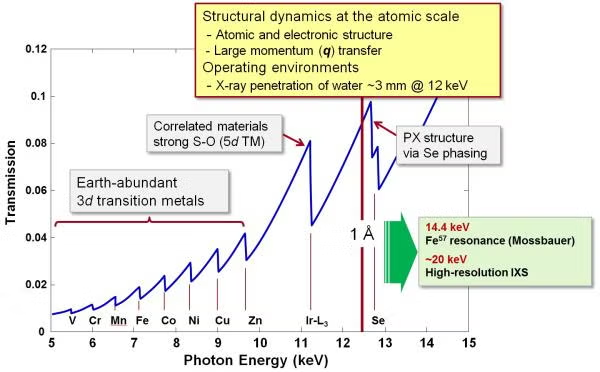LCLS-II-HE
LCLS-II will be the first XFEL to be based on continuous-wave superconducting accelerator technology (CW-SCRF), with a linac energy of 4 GeV and two tunable-gap undulators (SXU, HXU), to generate X-ray pulses from 0.25 to 5 keV (2.5 Å) at repetition rates up to 1 MHz. In parallel, the existing LCLS normal conducting linac will generate very high peak power pulses at 120 Hz at photon energies up to 25 keV.
The LCLS-II-HE project will increase the energy of the CW-SCRF linac to 8 GeV, enabling the photon energy range to be extended to at least 13 keV and potentially up to 20 keV at 1 MHz repetition rates.

The extension of high repetition rate XFELs to the hard X-ray regime is motivated by the scientific need for ultrafast atomic resolution (1 Å <=> 12.4 keV) with high average coherent X-ray power. The energy reach of LCLS-II-HE into the sub-Angstrom regime is a major enabling step for revealing structural dynamics at the atomic-scale, with the penetrating power and pulse structure needed for in-situ and operando studies of real-world materials and functioning assemblies. The ability to probe Earth-abundant elements and access experimental regimes central to biological structure determination and quantum materials studies will provide a fundamentally new capability for discovery science.
The spectral region beyond 5 keV (the design limit of LCLS-II) is critical for many areas of X-ray science. Access to Ångström wavelength (~12.4 keV) X-rays is a major enabling step for atomic-scale studies, while the ability to probe Earth-abundant elements and access experimental regimes central to biological structure determination and quantum materials studies will provide a fundamentally new capability for discovery science.

LCLS-II-HE represents a significant next step in the ongoing revolution in X-ray lasers and is a natural extension to LCLS-II, based on known CW-SCRF accelerator technology and using existing LCLS infrastructure. The hard X-ray regime has been used in more than 75% of LCLS experiments to date, thus LCLS-II-HE will provide a major advance in performance to the broadest cross-section of the user community. The LCLS-II-HE upgrade is projected to deliver two to three orders of magnitude increase in average spectral brightness beyond any proposed or envisioned diffraction-limited storage ring (DLSR), and will meet or exceed the anticipated performance of the European-XFEL by delivering X-ray pulses in a uniform (or programmable) time structure at a repetition rate of up to 1 MHz.
In additional to opening new areas of science for time-resolved studies, LCLS-II-HE will provide more than a 300-fold increase in average spectral flux (ph/s/meV) for high-resolution spectroscopy studies near the Fourier transform limit. Finally, the combination of an 8 GeV CW-SCRF linac (for high-repetition rate), and an independent 15 GeV Cu‑linac (120 Hz) will provide unmatched flexibility for simultaneous operation (and optimization) of both the HXU and SXU undulator sources for specific X-ray science needs.
The science needs for the capabilities of LCLS-II-HE have been developed by the international science community over many years. The LCLS-II-HE science case (SLAC-R-1143) provides a compilation of the most compelling science opportunities in seven broad areas:
- Fundamental dynamics of energy and charge in atoms and molecules
- Catalysis, photocatalysis, environmental and coordination chemistry
- Imaging biological function and structural dynamics
- Quantum materials
- Matter in extreme environments
- Nonlinear hard x-ray-matter interactions
The science opportunities for LCLS-II-HE continue to be refined and expanded, most recently through a series of “First Experiments” Meetings hosted at SLAC in 2017, followed by a workshop on advanced methods and instrumentation for LCLS-II-HE science hosted at SLAC in 2018 (see LCLS-II-II Meetings and Reports).
